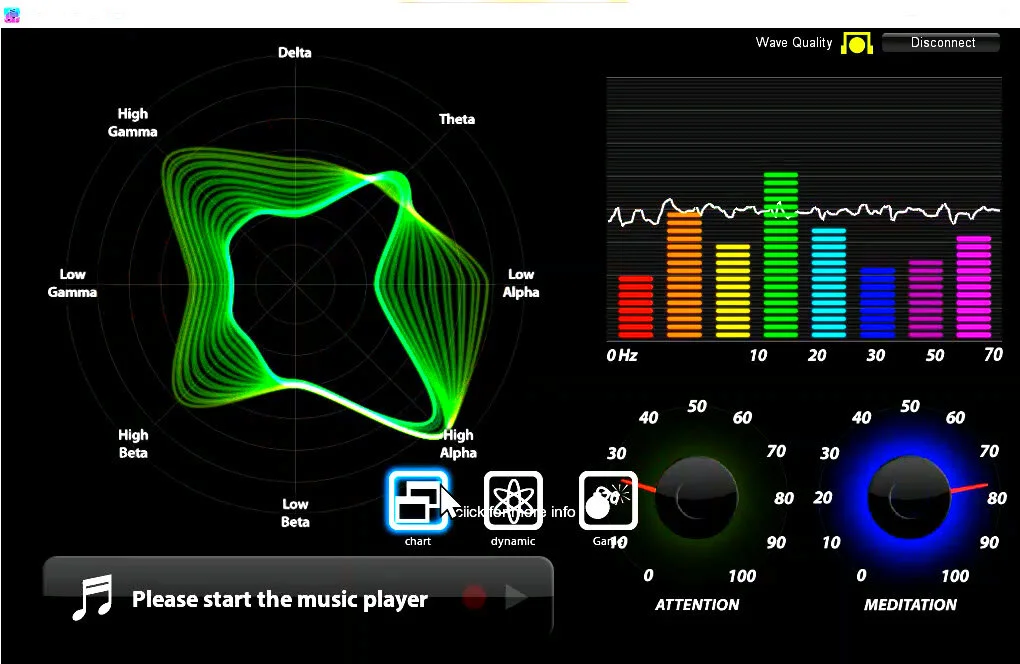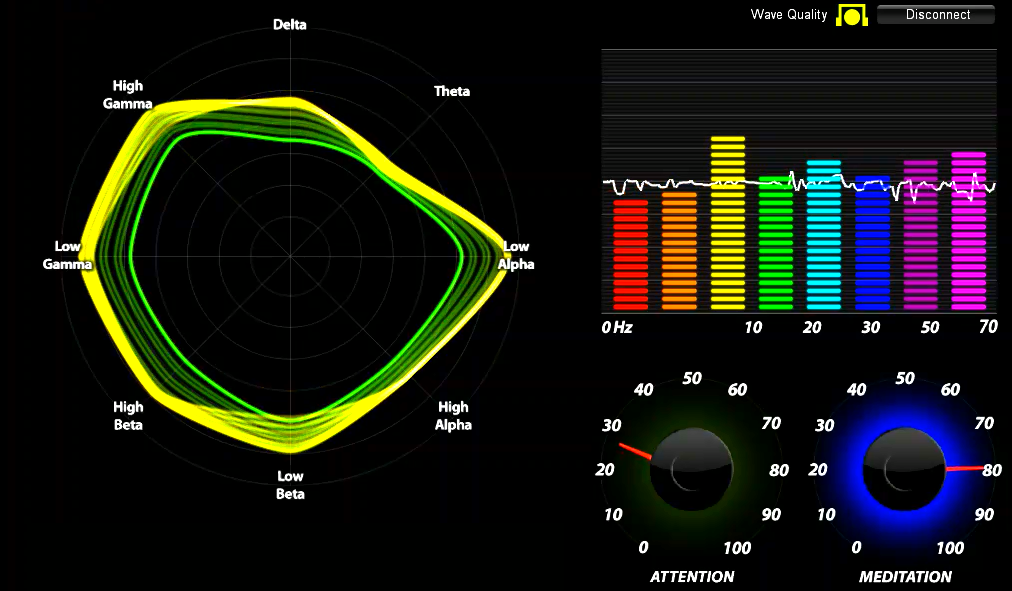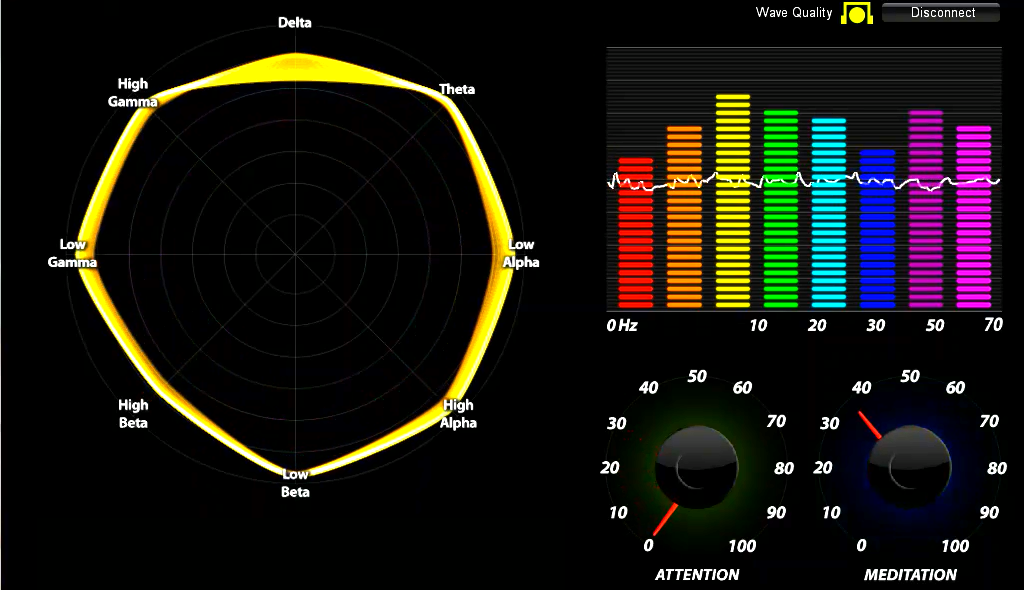Brainwaves reveal your emotions and state
Brainwaves are a result of the electrical impulses produced as our brain cells communicate with one another. They reveal how we respond and function at a moment in time. They can give us insights into:
our thought habits,
stress levels,
underlying mood
and overall brain function.
Our brainwaves change according to what we’re doing and feeling. When slower brainwaves are dominant we can feel tired, slow, sluggish, or dreamy. The higher frequencies are dominant when we feel wired, or hyper-alert.
The descriptions that follow are only broad descriptions - in practice things are far more complex, and brainwaves reflect different aspects when they occur in different locations in the brain.
Thompsons - 9 - Normal brainwave patterns can correspond to various mental states.
Description of brainwave functions
Tracking the dominant colour
Brainwave speed is measured in Hertz (cycles per second) and they are divided into bands delineating slow, moderate, and fast waves. They are measured in hertz and are divided levels for convinience.
Gamma brainwaves are the fastest of brain waves (high frequency, like a flute), and relate to simultaneous processing of information from different brain areas. Gamma brainwaves pass information rapidly and quietly.
The most subtle of the brainwave frequencies, the mind has to be quiet to access gamma.
Gamma was dismissed as 'spare brain noise' until researchers discovered it was highly active when in states of universal love, altruism, and the ‘higher virtues’. Gamma is also above the frequency of neuronal firing, so how it is generated remains a mystery.
It is speculated that gamma rhythms modulate perception and consciousness, and that a greater presence of gamma relates to expanded consciousness.
BETA WAVES (12 TO 38 HZ)
Beta brainwaves dominate our normal waking state of consciousness when attention is directed towards cognitive tasks and the outside world.
Beta is a ‘fast’ activity, present when we are alert, attentive, engaged in problem solving, judgment, decision making, or focused mental activity. Beta brainwaves are further divided into three bands;
Lo-Beta (Beta1, 12-15Hz) can be thought of as a 'fast idle', or musing.
Beta (Beta2, 15-22Hz) is high engagement or actively figuring something out.
Hi-Beta (Beta3, 22-38Hz) is highly complex thought, integrating new experiences, high anxiety, or excitement.
Continual high frequency processing is not a very efficient way to run the brain, as it takes a tremendous amount of energy.
Thompsons-
BETA WAVES (12 TO 38 HZ)
SMR WAVES (11 TO 15 HZ)
SMR protocol aims to inhibit Theta and High Beta, and reward Lo-Beta (SMR) at the at Cz or C4, based on the international 10-20 Brodmann scalp system.
The SMR frequency band (12-15 Hz) describes an alert, attentive state with relaxed or still physical movements.
The Neurofeedback training protocol used here aims to strengthen the quality of attention and the ability to sustain focus by building stronger neural networks (dlPFC and vlPFC link to limbic Pregenu Cingulate Cortex) which in turn promotes mind + brain + body coherence.
This training lowers the sleepy mind-wandering, or even habitual rumination found in Theta waves alongside the ‘spinning’ or anxious waves of High Beta.
While it builds a sense of calm relaxation with alertness, it also builds physical motor accuracy and balance.
ALPHA WAVES (8 TO 12 HZ)
Alpha brainwaves are dominant during quietly flowing thoughts, and in some meditative states.
Alpha is ‘the power of now’, being here, in the present. Alpha is the resting state for the brain.
Alpha waves aid overall mental coordination, calmness, alertness, mind/body integration and learning.
Thompsons p 9: 8 - 10 Hz are found in dissociative states.
THETA WAVES (3 TO 8 HZ)
Theta brainwaves occur most often in sleep but are also dominant in deep meditation.
Theta is our gateway to learning, memory, and intuition. In theta, our senses are withdrawn from the external world and focused on signals originating from within. It is that twilight state which we normally only experience fleetingly as we wake or drift off to sleep. In theta we are in a dream; vivid imagery, intuition and information beyond our normal conscious awareness. It’s where we hold our ‘stuff’, our fears, troubled history, and nightmares.
Thompsons p 9: 4 - 7 Hz are found in drowsy states and when creative thoughts occur.
DELTA WAVES (.5 - 3 HZ)
Delta brainwaves are slow, loud brainwaves (low frequency and deeply penetrating, like a drum beat). Delta waves suspend external awareness and are the source of empathy.
Healing and regeneration are stimulated in this state, and that is why deep restorative sleep is so essential to the healing process. They are also generated in deepest meditation and dreamless sleep.
Thompsons 9: 5 - 3 Hz are found in sleep, learning disabilities and brain injury.
Infra-Low brainwaves (also known as Slow Cortical Potentials), are thought to be the basic cortical rhythms that underlie our higher brain functions. Very little is known about infra-low brainwaves. Their slow nature make them difficult to detect and accurately measure, so few studies have been done. They appear to take a major role in brain timing and network function.
This requires a clinical approach and QUEEG Brain Mapping.
INFRA-LOW (<.5HZ)
What your brainwaves mean to you
Our brainwave profile and our daily experience of the world are inseparable. When our brainwaves are out of balance, there will be corresponding problems in our emotional or neuro-physical health. Research has identified brainwave patterns associated with all sorts of emotional and neurological conditions. more...
Over-arousal in certain brain areas is linked with anxiety disorders, sleep problems, nightmares, hyper-vigilance, impulsive behaviour, anger/aggression, agitated depression, chronic nerve pain and spasticity. Under-arousal in certain brain areas leads to some types of depression, attention deficit, chronic pain and insomnia. A combination of under-arousal and over-arousal is seen in cases of anxiety, depression and ADHD. more...
Instabilities in brain rhythms correlate with tics, obsessive-compulsive disorder, aggressive behaviour, rage, bruxism, panic attacks, bipolar disorder, migraines, narcolepsy, epilepsy, sleep apnea, vertigo, tinnitus, anorexia/bulimia, PMT, diabetes, hypoglycemia and explosive behaviour. more...























